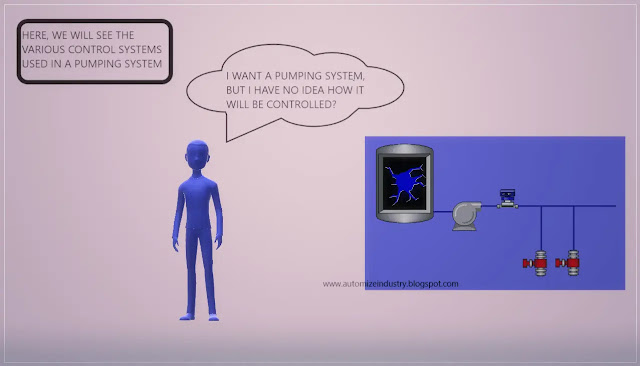Pump Control Systems
18 Sept, 2022.
In this
post, we will see the various control methods used in a pumping system.
In pumping, various control systems are used to control the sequencing and speed of pumps in a system. Two broad categories are system set point control and pump sequencing control. System set point control will determine the hydraulic system operation, and pump sequencing control will determine the pump performance. In this post, we will see these two general types and understand the various control methods used in a pumping system.
System Set Point Control:
1. Proportional Control:
This method will permit a pumping system to change proportionally within specified limits and with specific functions occurring to maintain those limits. An example of this type of control is a pumping system with wet well as shown below. Liquid flows into the well at various rates. The main objective is to pump out the liquid with gradual changes in flow.
Lead and lag pumps pump liquid out at variable flow rates to maintain the liquid with certain levels in the well as the inflow changes. At full speed, both pumps have ample capacity to keep the wet well from overflowing. Controlling the functions between maximum and minimum levels (1 and 6 here in the figure) is proportional control. The speed of the pumps will be controlled to change proportionally with the level, as it rises or falls within specified levels.
Many wet well installations use proportional programming control – but in some cases, proportional plus integral control is also used. There are many different variations of level-sensing proportional control.
2. Proportional Plus Integral Control:
It will permit the pumping system to maintain a relatively constant hydraulic system operation, with specific functions occurring to maintain a constant set point. An example is shown in below figure.
Water demand in the system keeps changing as various valves are opened and closed. The objective is to maintain constant pressure in the system as the flow changes. It is to be noted that the pump head drops as the flow increases at a fixed speed. Increasing the speed with the same flow rate will increase the head or pressure to keep it constant. A surge or cushion tank is required in these systems to dampen pressure transients in the system.
In this example, as the flow is increased, the pressure will start dropping from it’s constant point. The speed control signal will change to whatever value is necessary to bring the pressure back to it’s constant point. The faster and greater the pressure change, the larger the value of signal generated in the control to correct the speed.
A pressure sensor is used to sense the pressure in the system and provide the feedback for the integral control system. Controlling the system between relatively small ranges to maintain a constant set point is called proportional plus integral control and can be used to maintain constant pressure, constant flow or constant level in a pumping system.
Pump Sequencing Control:
1. Pump Staging Control:
This system will permit two or more pumps to operate individually in sequence to satisfy the hydraulic system demand. For example, a lead pump may operate over a speed range to deliver minimum to maximum flow. If the flow demand continues to increase, the lead pump will remain at full speed, and the lag pump will operate over a speed range to deliver it’s minimum to maximum flow. The pumps will operate in a similar manner on decreasing demand.
2. Pump Load Share Control:
This system will permit two or more pumps to operate together to share the load to satisfy the hydraulic system demand. For example, a lead pump may operate over a speed range to deliver minimum to maximum flow. If the flow demand continues to increase, both the lead and lag pumps will be adjusted to the same speed to meet the flow demand, thereby sharing the load. On decreasing demand, below maximum output of the lead pump, the lag pump will shut down and the lead pump will operate over the speed range.
I have covered the general principles used in controlling pumping systems. I have also not attempted to cover every theory of these types deeply; you can learn it easily once you get familiar with them. I have just given you an insight of these types of controls. Once you are done with these, I am hopeful you will be easily able to understand any pumping system properly. Learn the basics and explore a new type of study in this type of automation. It will take some practice and as you go on studying the pumping system, you will become more familiar with it.
Thank you guys; I hope you enjoyed reading the practices normally used for this type of study in industrial automation.






Comments
Post a Comment
If you have any queries, please let me know